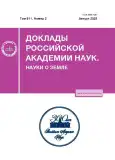METHODOLOGY OF REMOTE ASSESSMENT OF THE CHARACTERISTICS OF UNEXPLORED LAKES OF THE CONTINENTAL PART OF THE RUSSIAN TUNDRA
- Authors: Zverev I.S.1, Golosov S.D.1, Kondratiev S.A.1, Rasulova A.M.1
-
Affiliations:
- Institute of Limnology of the Russian Academy of Sciences
- Issue: Vol 511, No 2 (2023)
- Pages: 254-260
- Section: LAND WATERS PROBLEMS
- Submitted: 14.10.2023
- Published: 01.08.2023
- URL: https://journals.rcsi.science/2686-7397/article/view/135876
- DOI: https://doi.org/10.31857/S2686739723600650
- EDN: https://elibrary.ru/WGECPU
- ID: 135876
Cite item
Full Text
Abstract
A methodology has been proposed to assess the hydrophysical and chemical-biological characteristics of unexplored small and medium lakes (with an area of up to 100 km2) in the Arctic territories of Russia using remote sensing and mathematical modeling methods. The methodology is based on the use of a one-dimensional model of hydrothermodynamic and chemical-biological processes in water bodies FLake. The technique makes it possible to obtain an estimate of heat transfer between the atmosphere, ice, water, and bottom sediments, the date of ice cover formation, its thickness, and duration of existence of freeze-up, calculate profiles of water and bottom sediment temperature and dissolved oxygen by depth based on information on geographical coordinates and lake’s surface area. Contact measurements are not required, which is extremely important for hard-to-reach and poorly explored northern territories of our country.
Keywords
About the authors
I. S. Zverev
Institute of Limnology of the Russian Academy of Sciences
Email: ARasulova@limno.ru
Russian Federation, St. Petersburg
S. D. Golosov
Institute of Limnology of the Russian Academy of Sciences
Email: ARasulova@limno.ru
Russian Federation, St. Petersburg
S. A. Kondratiev
Institute of Limnology of the Russian Academy of Sciences
Email: ARasulova@limno.ru
Russian Federation, St. Petersburg
A. M. Rasulova
Institute of Limnology of the Russian Academy of Sciences
Author for correspondence.
Email: ARasulova@limno.ru
Russian Federation, St. Petersburg
References
- Измайлова А.В. Водные ресурсы озер Российской Федерации // География и природные ресурсы. 2016. № 4. С. 5–14.
- Кочков Н.В., Рянжин С.В. Методика оценки морфометрических характеристик озер с использованием спутниковой информации // Водные ресурсы. 2016. Т. 43. № 1. С. 18–23.
- Мякишева Н.В. Многокритериальная классификация озер. СПб.: изд. РГГМУ, 2009. 160 с.
- Павлов А.В. Термический режим равнинных озер Севера // Криосфера Земли. 1999. Т. 3. № 3. С. 59–70.
- Румянцев В.А., Измайлова А.В., Макаров А.С. Состояние озерного фонда Арктической зоны Российской Федерации // Вестник РАН. 2021. Т. 91. № 2. С. 115–126.
- Румянцев В.А., Измайлова А.В., Крюков Л.Н. Состояние водных ресурсов озер арктической зоны Российской Федерации // Проблемы Арктики и Антарктики. 2018. Т. 64. № 1. С. 84–100.
- СТО ГГИ 52.08.40-2017 Определение морфометрических характеристик водных объектов суши и их водосборов с использованием технологии географических информационных систем по цифровым картам РФ и спутниковым снимкам // Федеральная служба по гидрометеорологии и мониторингу окружающей среды (Росгидромет). СПб.: ООО “РПЦ Офорт”, 2017. 148 с.
- Стратегия развития Арктической зоны Российской Федерации и обеспечения национальной безопасности на период до 2035 года // Утверждена Указом Президента Российской Федерации № 645 от 26 октября 2020 года. http://kremlin.ru/acts/news/64274 (дата обращения: 01.02.2023).
- Тержевик А.Ю., Пальшин Н.И., Голосов С.Д. и др. Гидрофизические аспекты формирования кислородного режима мелководного озера, покрытого льдом // Водные ресурсы. 2010. Т. 5, № 5. С. 568–580.
- Шадрина А.А., Федорова И.В., Голосов С.Д., Евдокимов А.А., Бойке Дж. Термический режим озер Арктики // Динамика и термика рек, водохранилищ и прибрежной зоны морей. Тр. VIII Межд. н.-практ. конф., 2014. Т. 1. М., РУДН, 24–27.11 2014. С. 581–589.
- Шульга М. Представление озер в моделях погоды и климата: внешние параметры, объективный анализ температуры поверхности воды и верификация / Дисс. … уч. ст. канд. физ.-мат. наук. СПб.: РГГМУ, 2015. 217 с.
- Golosov S., Kirillin G.A. parameterized model of heat storage by lake sediments // Environmental. Modelling & Software. 2010. V. 25 (6). P. 793–801. https://doi.org/10.1016/j.envsoft.2010.01.002
- Golosov S., Maher O.A., Schipunova E., et al. Physical Background of Oxygen Depletion Development in Ice-Covered Lakes // Oecologia, Springer Verlag. 2007. V. 151. P. 331–340.
- Kirillin G., Hochschild J., Mironov D., Terzhevik A., Golosov S., Nutzmann G. FLake-Global: Online lake model with worldwide coverage // Environmental Modelling & Software. 2011.V. 26. Iss. 5. P. 683–684.
- Messager M., Lehner B., Grill G., et al. Estimating the volume and age of water stored in global lakes using a geo-statistical approach // Nat Commun. 2016. V. 7 (1). 13603. https://doi.org/10.1038/ncomms13603
- Mironov D., Heise E., Kourzeneva E., et al. Implementation of the lake parameterization scheme Flake into the numerical weather prediction model COSMO // Boreal environ. Res. 2010. V. 15. P. 218–230.
- Zdorovennov R., Golosov S., Zverev I., Zdorovennova G., Fedorova I. Arctic climate variability and ice regime of the Lena River delta lakes// E3S Web of Conferences. V. 163. 04008, 2020. https://doi.org/10.1051/e3sconf/202016304008
Supplementary files













